Politics
West Bengal: Another Bihar For BJP, Only Worse
Suryakiran Tiwari and Hari Kasula
Apr 04, 2016, 03:05 PM | Updated 03:05 PM IST
Save & read from anywhere!
Bookmark stories for easy access on any device or the Swarajya app.
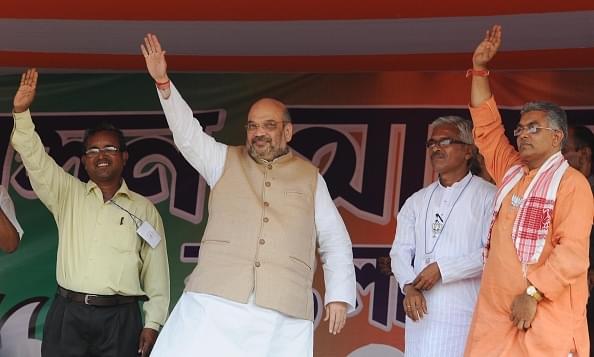
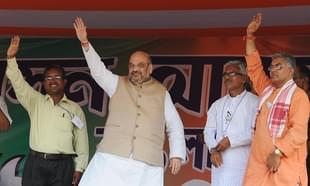
- Bengali voters see a clear distinction between the BJP at the Centre and the BJP in West Bengal, and voters are giving greater relevance to the latter.
-
To present itself as a viable alternative, the BJP needs strong local leadership and a dedicated vote bank, both of which are missing.
Undoubtedly, the battle for the West Bengal Assembly is primarily between TMC and Left Front. But the BJP is trying hard to make an impression by leveraging its story of running the country successfully, in a state where state-centric politics have traditionally decided matters.
BJP Recorded Success In 2014 Lok Sabha Polls
BJP recorded a vote share of 17 percent in the 2014 Lok Sabha polls (four times its vote share in the 2011 assembly polls), riding on the Modi wave and helped by the decline of the Left and Congress nationally. Its vote share was double that of Congress and its seat tally same as that of the Left Front.
This provided hope to its supporters that the party could emerge as the principal opposition to Mamata in 2016 and even take a shot at forming the government. BJP received good support from upper caste, middle class, urban and graduate voters. In fact, its vote share among urban voters and graduates was higher than that of the Left Front. Its vote share across all categories was better than Congress’, except among Muslims and illiterates.
Vote Share Expected To Drop In 2016 State Polls
If votes in favor of the BJP in the state are counted today, the BJP stands at 13 percent. It is neither Chief Minister Mamata Banerjee nor Suryakanth Mishra of the Left Front who stands between the BJP and electoral success in West Bengal today, but rather a politically sophisticated voter.
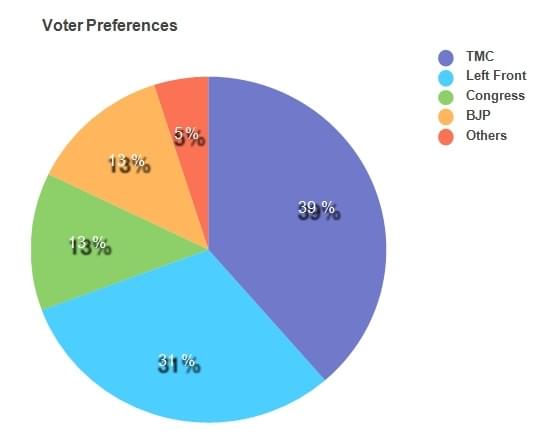
The politically sophisticated West Bengal voter yet again proves that Delhi’s Diamond may not hold a diamond’s value everywhere else. This comes as no surprise to those who are watching regional dynamics closely, but not for Prime Minister Narendra Modi and the BJP chief Amit Shah. They continue to put money on losing bets based on failed formulas. Looking at our research findings from the “Bengal Voter Mapping Project”, it is more apt to give credit to the Bengali voter’s political sophistication, than to blame the BJP national leadership’s inability to learn from its past electoral mistakes.
Poor Conversion Rate Despite High Approval Ratings For Modi’s Performance
Bengali voters see a clear distinction between the party that is running the central government and its state wing which aspires to run the West Bengal state government. Modi garners a healthy approval rate of 40 percent among Bengali voters. But this support can’t be considered support for BJP in the 2016 West Bengal Assembly elections.
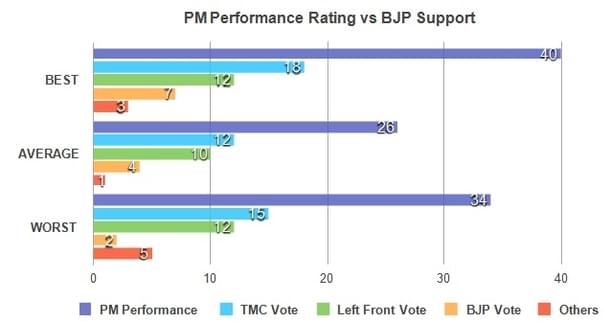
A closer look at trends reveals that out of the 40 percent who approve of Modi as the country’s leader, 18 percent are voting for the TMC and 12 percent prefer the Left Front. The voter’s sophistication extends beyond this and has a general preference to have the same party running the state and the Centre. If this gives the idea that voters of West Bengal want the BJP to run the state, think again. Of the 51 percent who prefer to have the same party at the Centre and in the state, 23 percent were referring to the TMC and 14 percent implied support for the Left Front.
Lack Of Credible And Persuasive Local Leadership
There is a clear line drawn between the BJP at the Centre and the BJP in the state, and voters have restricted the relevance of BJP in this election to the state BJP. 28 percent of the voters are either proud of the state BJP, or are strongly hopeful that the state BJP is going to make a significant difference in the state’s electoral politics. It is not surprising that 38 percent of the voters who are either angry or afraid of the BJP are backing either TMC or Left Front.
The noteworthy fact is that only eight percent of the 28 percent pro-BJP voters are voting for the BJP, while 10 percent of them are with the TMC and the remaining seven percent is voting for the Left Front. Clearly, the state BJP lacks the crucial characteristic which is likely to earn voter support in this election – persuasive leadership.
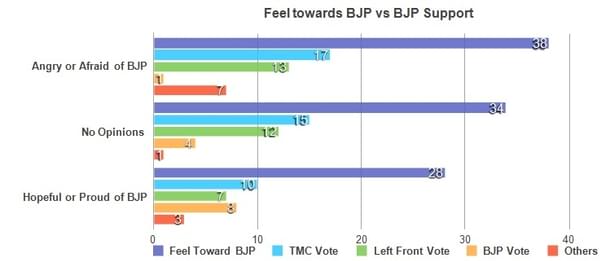
16 percent voters strongly approve of PM Modi’s leadership and want similar leadership in Bengal, but the lack of credible leadership in the state means that only a half of those voters support the BJP in West Bengal. As much as the BJP national leadership wants to sell PM Modi’s proven governance, Bengali voters have their own criteria – at least in evaluating the BJP.
While 51 percent see the state BJP as being either incapable or poor in addressing state issues, only 19 percent of the voters give the BJP a thumbs-up, and of these, only nine percent are voting for the BJP, with the rest split between TMC (six percent) and Left Front (three percent). This once again shows that the lack of credible leadership is costing the BJP 10 percentage points in its electoral performance.
Mistakes Of The BJP Campaign
Unrealistic targets are also leading to a loss of focus. A vote share of 13 percent is not bad – it is three times the vote share of the 2011 state polls. Given that 17 percent of the voters voted for BJP in the 2014 Lok Sabha polls because of Modi, this adjustment was expected. The Modi factor has been conspicuous by its absence in state polls (Delhi and Bihar) because of regional dynamics.
Every state cannot be like Haryana, where the BJP’s tally went up from four seats in 2009 to 47 seats in 2014. The BJP ended up forming the government. This was primarily due to the fact that the BJP was seen as the only viable alternative to the Congress in the state. In fact, in all the state elections which the BJP won post the 2014 Lok Sabha polls (Maharashtra, Haryana and Jharkhand), people considered the BJP as the most potent alternative to the incumbent regime; it was not the Modi factor alone.
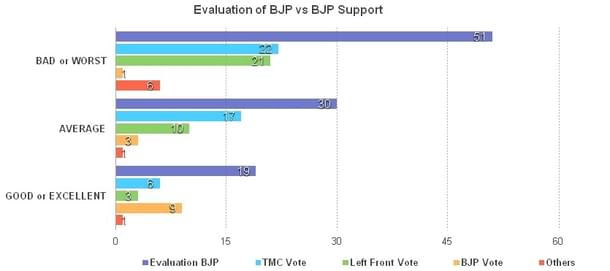
To present yourself as a viable alternative, you need strong local leadership (which is absent in West Bengal) and a dedicated vote bank (which is missing). There are no short cuts in politics; it took decades of hard work for Mamata to finally dislodge the Left from power in 2011. Paradropping the national leadership won’t help much, just as it didn’t in Delhi and Bihar.
As soon as the BJP performed well in the state, it should have cultivated strong local leadership in the state to prepare the ground for the state polls. It had two years. The other option would have been to do something similar to its strategy in Assam – induct a strong leader like Sonowal into the cabinet, groom him and launch him well ahead of the polls. Even Suraykanth Mishra’s hardcore fans would agree that he lacks the charisma of Jyoti Basu or Buddhadeb. There is a leadership vacuum in the state which Mamata is taking advantage of. Babul Supriyo’s choice in the cabinet is thus questionable as he is a political novice.
The landscape of Bengal also provided an opportunity to the BJP to experiment and shed the inhibition that it is a party representing Hindus. After all, it had nothing to lose. The BJP is always criticized of issuing very few tickets to Muslim candidates. It was announced in December 2015 that the party would field Muslim candidates in areas where they are dominant, totaling some 44 seats. However, the list has Muslim candidates numbering in single digits. Frustrated, the state minority cell chief has left the party.
BJP strategists may have thought that Muslim votes will be split between TMC and Left Front, and in the midst of this, a Hindu candidate could win. But the whole episode has left a bad taste among liberal, educated Muslim voters. As many as 28 percent of the community’s voters as per our survey could switch to another party in these polls.
The BJP is struggling to shed its ‘bahari’ tag in Bengal. Firstly, it doesn’t have many tall Bengali-speaking leaders. In addition, many tickets have been distributed to film/art/sports personalities who lack political acumen and experience.
Situation Is Not All Bleak For The BJP
In addition to cultivating credible local leadership, there are a couple more areas where the BJP can concentrate to maximize its vote share. Leaving aside voters who hate the BJP both in the state and at the Centre (31 percent) and those who rate PM Modi high and rate the state BJP low (12 percent), 13 percent of the voters are available to the BJP for persuasion. These voters are extremely proud of the Central Government’s achievements under BJP rule, but perceive the state BJP as an average performer. If Amit Shah and PM Modi can break into this group, the BJP can raise its numbers.
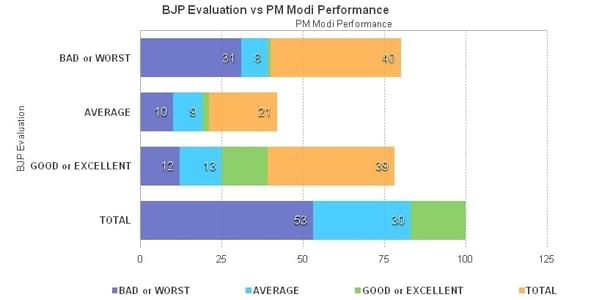
Another target segment for the BJP to focus on is the sector of voters who desire to have the same party running both the state and central governments, and are neither voters of TMC nor the Left Front. These are about 14 percent of the electorate and rate the state BJP’s ability to govern well as ‘average’. Although this is a huge chunk of targetable voters, the BJP can garner a maximum of three to five percent from this segment – if successful – as it is too late in the game and only three to five percent of the vote is available for persuasion.
As a word of caution, if the BJP wants to use polarization tactics, they may face the same consequences as they did in Bihar in the aftermath of ‘beef politics’. The voting bloc which is most likely to vote as a coherent social group made up its mind early in the election cycle and these voters are most likely to be committed to their existing preferences. At this stage, a polarizing message hardly yields any votes for the BJP. On the contrary, voters of Bengal credit the BJP for the successful implementation of ‘Swacch Bharat’ (10 percent) and the National Highways Program (five percent).
In this context, the BJP’s strategy is too incoherent at the moment. Concentrated efforts should be made to maintain and penetrate deeper into the four segments which gave the BJP significant support in the Lok Sabha polls – urban population, upper caste Hindus, educated (graduates) and first time voters (ages of 18-25). Its vote share in these segments ranged from 18 percent to 29 percent, higher than its state average. Slogans and sops in the manifesto should target this group. This is the support base which can form a loyal vote bank for the party as the BJP connects with their aspirations. For example, 49 percent of the people are dissatisfied with the TMC government on employment issues (a topic of interest for the educated youth).
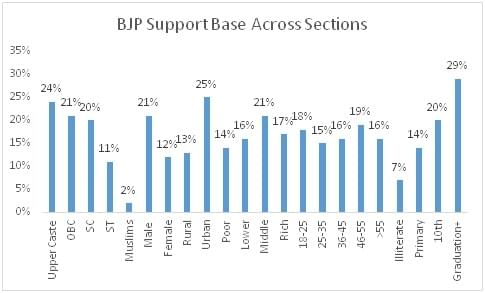
To summarize, West Bengal’s highly sophisticated voter is a tough nut to crack for the BJP national leadership. If they are successful in persuading the aforementioned segments, they would end up with anywhere between 13 and 18 percent of the vote share. Whether this would yield 40 to 50 seats, as Amit Shah claims, is a matter of how concentrated this support base is and how close the winning margin is.
Make no mistake: majority of West Bengal approves of Narendra Modi as the leader of the nation, but not of the BJP as a party to lead the state yet. It is only a matter of time before we see how the BJP fares, a giant or a pygmy.





